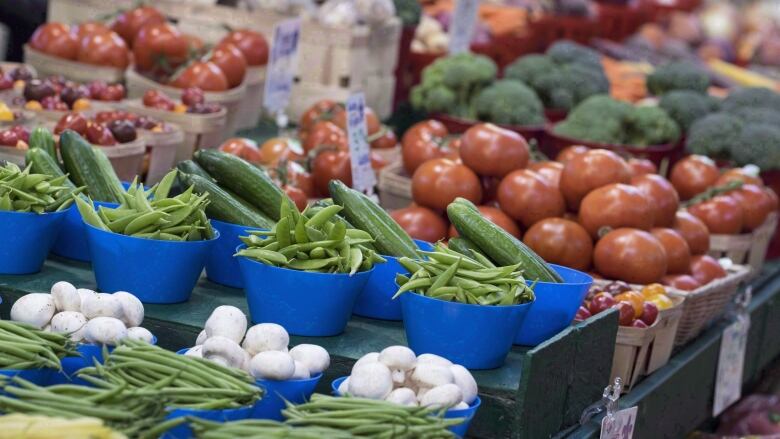New food guide set to challenge prominence of meat, dairy industries
Will likely force change across Canada's agricultural industry

Health Canada unveiled a radically new food guide Tuesday that eliminates food groups, encourages plant-based foods over meat and dairy products, and is likely to force changes across the country's agricultural industry.
"I see the food guide as a challenge for many industries," said Simon Somogyi, a University of Guelph professor studying the business of food. "How they adapt will be of interest."
Meat enjoyed a dominant position in the previous food guide, with a meat-and-alternatives category and a recommended two to three servings daily for adults depending on their sex and age. It now features much less prominently. The new guide encourages people to "eat protein foods," but choose those that come from plants more often.
It's a win for plant-protein farmers, like those growing beans, chickpeas and lentils, but a potential threat to meat producers.
Somogyi believes consumers will favour high-quality beef when they choose to consume red meat, and farmers will likely want to shift to producing niche products.
If Canadians eat less meat, there may be opportunities to export to Asian markets, where a middle-class consumer wants safe, high-quality cuts.
"If the Canadian beef sector can provide that then their future looks bright," Somogyi said.
The industry may also want to collaborate with plant-protein producers, said Sylvain Charlebois, a Dalhousie University professor who researches food.
He recently spoke about the upcoming food guide withhundreds of people in the beef industrywho he said were not overly happy with the plant-based narrative, and he suggested they "befriend the enemy."
For instance, that kind of partnership could promote a meat loaf recipe that contains beef and lentils, he said.
A rethink for dairy supply management?
The new guide also minimizes dairy consumption. It touts water not milk as the "drink of choice" and eliminates the previous milk-and-alternatives food group. The visual guide shows a plate topped with a variety of produce, protein and whole grains, but the only dairy pictured is yogurt.
The encouragement to consume less dairy contradicts Canada's supply management system and doesn't leave a choice but to rethink the status quo, said Charlebois.
The system started in the 1970s and sets quotas for production of milk and other goods based on anticipated demand.
Canadians will eventually buy less dairy as they adhere to the new guide's recommendations, he said, and grocers will shrink the amount of space allotted to dairy in stores.
Farmers will have to start looking at export markets, and that's not possible under the current system, he said.
"You'll end up with an imbalance. So obviously, I think you need to look at supply management 2.0 very seriously and commit to a reform as soon as possible."
The guide is a challenge for the Canadian dairy sector to look at what other markets there are and what those products are in other countries.-SimonSomogyi, University ofGuelph
Somogyi suggests dairy farmers eye opportunities in export markets, such as rising demand for infant formula in China and parts of southeast Asia.
"In some ways, the guide is a challenge for the Canadian dairy sector to look at what other markets there are and what those products are in other countries."
Fruits don't get off scot-free either. While the new guide recommends "plenty" of vegetables and fruits, it suggests people "replace juice with water."
That directive could hurt Canada's apple producers, which supply part of their crop to juice processing, said Somogyi.
The heavy emphasis on eating whole produce also highlights the need for farms to grow more fruit and vegetables locally, said Charlebois.
Canada imports much of its produce, leaving Canadians vulnerable to wild price fluctuations, he said. The consumer price index for fresh lettuce, for example, jumped 39.9 per cent from December 2017 to December 2018, according to Statistics Canada.
There's less risk to local production, he said, and Canada needs to build its economies of scale for produce farming.

Opportunity in plant-based protein
The changes to the food guide shouldn't come as a surprise to industry, as experts expected much of what's in the new guide and it simply reflects changing consumer eating habits.
"This is already happening," said Somogyi, whose research shows a growing number of Canadians are becoming vegetarian or eating less meat. "I think the food guide makes it a little clearer."
The restaurant industry and some processors have been adjusting to increased demand for plant-based protein for years.
"It's one of the most impactful, fast-growing trends right now in the industry," said Robert Carter, executive director of food service for market research firm NPD Group.
A&W Canada added a veggie burger to its menu last year, and Maple Leaf Foodshas been adding alternative-protein makers to its portfolio in a bid to become the most sustainable protein company on earth.
"Everyone seems to really have all of a sudden jumped on board."












_(720p).jpg)


 OFFICIAL HD MUSIC VIDEO.jpg)
.jpg)








































































































